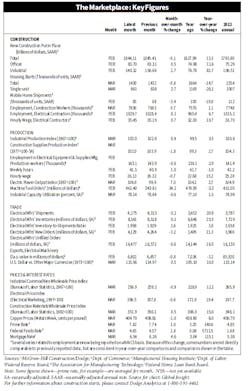Electrical Marketing's Leading Economic Indicators - April 21, 2023
March building permits drop big-time
Privately‐owned housing units authorized by building permits in March were at a seasonally adjusted annual rate of 1,413,000. This is -8.8% below the revised February rate of 1,550,000 and is -24.8% below the March 2022 rate of 1,879,000. Single‐family authorizations in March were at a rate of 818,000, +4.1% above the revised February figure of 786,000. Authorizations of units in buildings with five units or more were at a rate of 543,000 in March.
Architects slightly more optimistic in March
Architecture firms reported a modest increase in March billings, according to the March Architecture Billings Index (ABI) published by the American Institute of Architects (AIA). This positive news was tempered by a slight decrease in new design contracts ). March was the first time since last September in which billings improved.
The billings score for March increased from 48.0 in February to 50.4 in March (any score above 50 indicates an increase in firm billings). However, firms reported that inquiries into new projects grew at a slower pace, while the value of new design contracts declined from 51.3 in February to 48.9 in March.
“In spite of the positive movement in architecture firm billings in March, core concerns remain., “said AIA Chief Economist, Kermit Baker. “Inflation still needs to ease further for interest rates to return to more normal levels, and the banking turmoil still threatens to hold back residential and commercial construction loans.”
ABC reports that construction backlog slips to lowest level since Aug. 2022
Associated Builders and Contractors reported that its Construction Backlog Indicator declined to 8.7 months in March, according to a member survey conducted March 20 to April 3.
That reading is 0.4 months higher than in March 2022. Backlog slipped in March and is now at its lowest level since Aug. 2022. Backlog is down on a monthly basis in every region except for the South, which continues to be associated with elevated levels of current and future construction activity.
Freight rail activity still soft compared to 2022
The latest data from the American Association of Railroads (AAR) show that for the week ending April 8, total U.S. weekly rail traffic was 451,336 carloads and intermodal units, down -11.2% compared with the same week last year.
For the first 14 weeks of 2023, U.S. railroads reported cumulative volume of 3,219,161 carloads, down -0.1% from the same point last year; and 3,249,230 intermodal units, down -10.8% from last year. Total combined U.S. traffic for the first 14 weeks of 2023 was 6,468,391 carloads and intermodal units, a decrease of -5.8% compared to last year.
Baker-Hughes reports on steady growth in oil rig activity
The latest data on rig counts at www.rigcount.bakerhughes.com showed that although operating rigs through the week ending April 6 dropped down four rigs to 751 rigs, it’s still up 62 rigs YOY for a +9% YOY gain. None of the major basins saw any rig activity change by more than one rig. The Permian Basin, the nation's largest, has 353 rigs online, up 21 rigs over this time last year.



